Examination of Partnership Taxation and Fringe Benefit Tax (FBT) Law
VerifiedAdded on 2023/04/25
|11
|2214
|288
Report
AI Summary
This report provides a detailed analysis of partnership taxation and Fringe Benefit Tax (FBT) provisions under Australian taxation law. It begins with an overview of income tax legislation, specifically ITAA 36 and ITAA 97, and their application to partnerships. The report includes a calculation of net partnership income, considering various income and expense items with detailed working notes explaining the treatment of items such as credit sales, stock adjustments, car expenses, electricity expenses, and depreciation. It also addresses the deductibility of repair expenses and interest on loans. Furthermore, the report examines the provisions of FBT, explaining its chargeability, valuation, and consequences for employers, including calculations for school fee payments and accommodation benefits. The analysis incorporates relevant sections of the Income Tax Assessment Act and Fringe Benefit Tax Assessment Act, along with references to case law and scholarly articles to support its conclusions. Desklib provides access to this and other solved assignments for students.
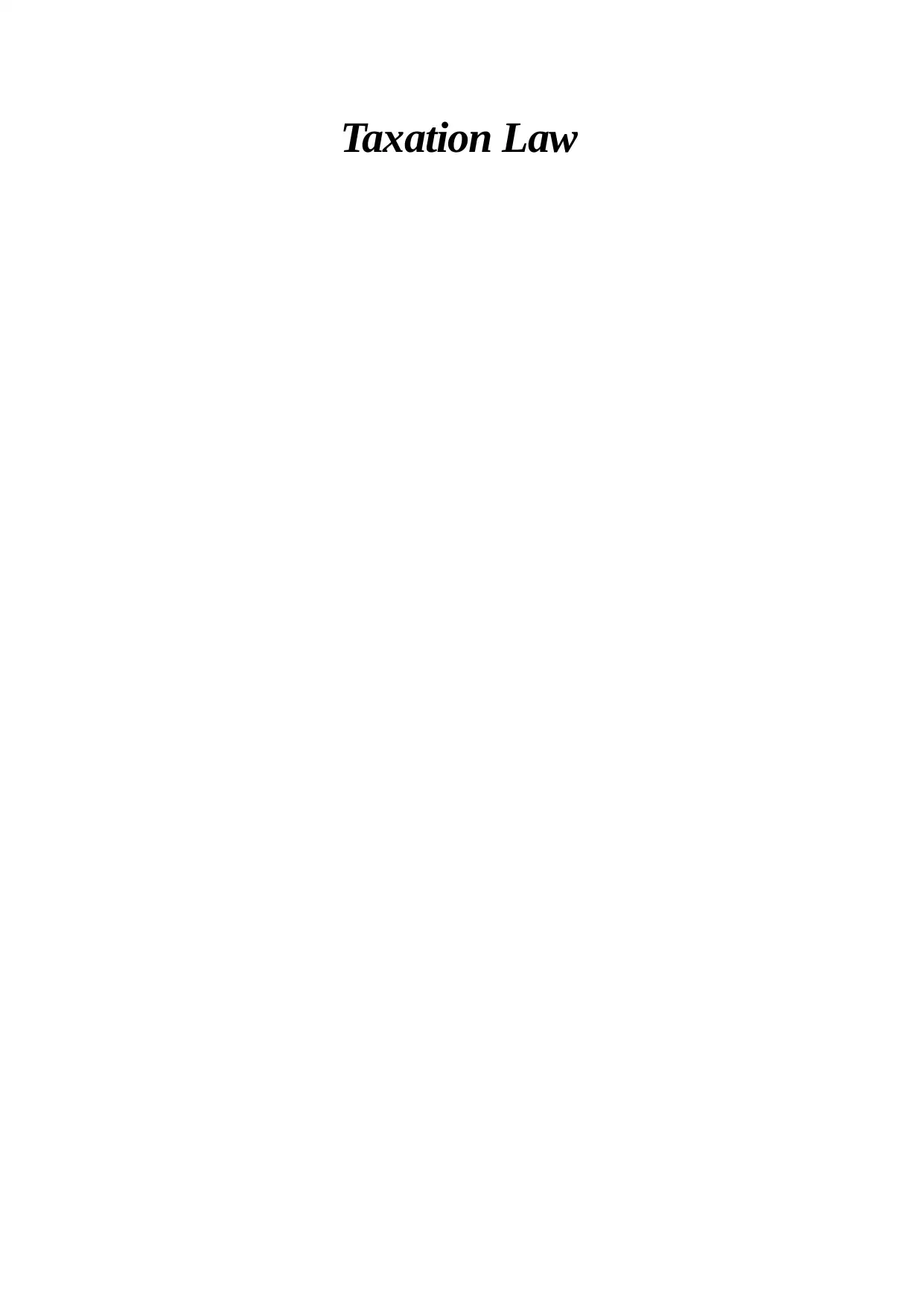
Taxation Law
Paraphrase This Document
Need a fresh take? Get an instant paraphrase of this document with our AI Paraphraser
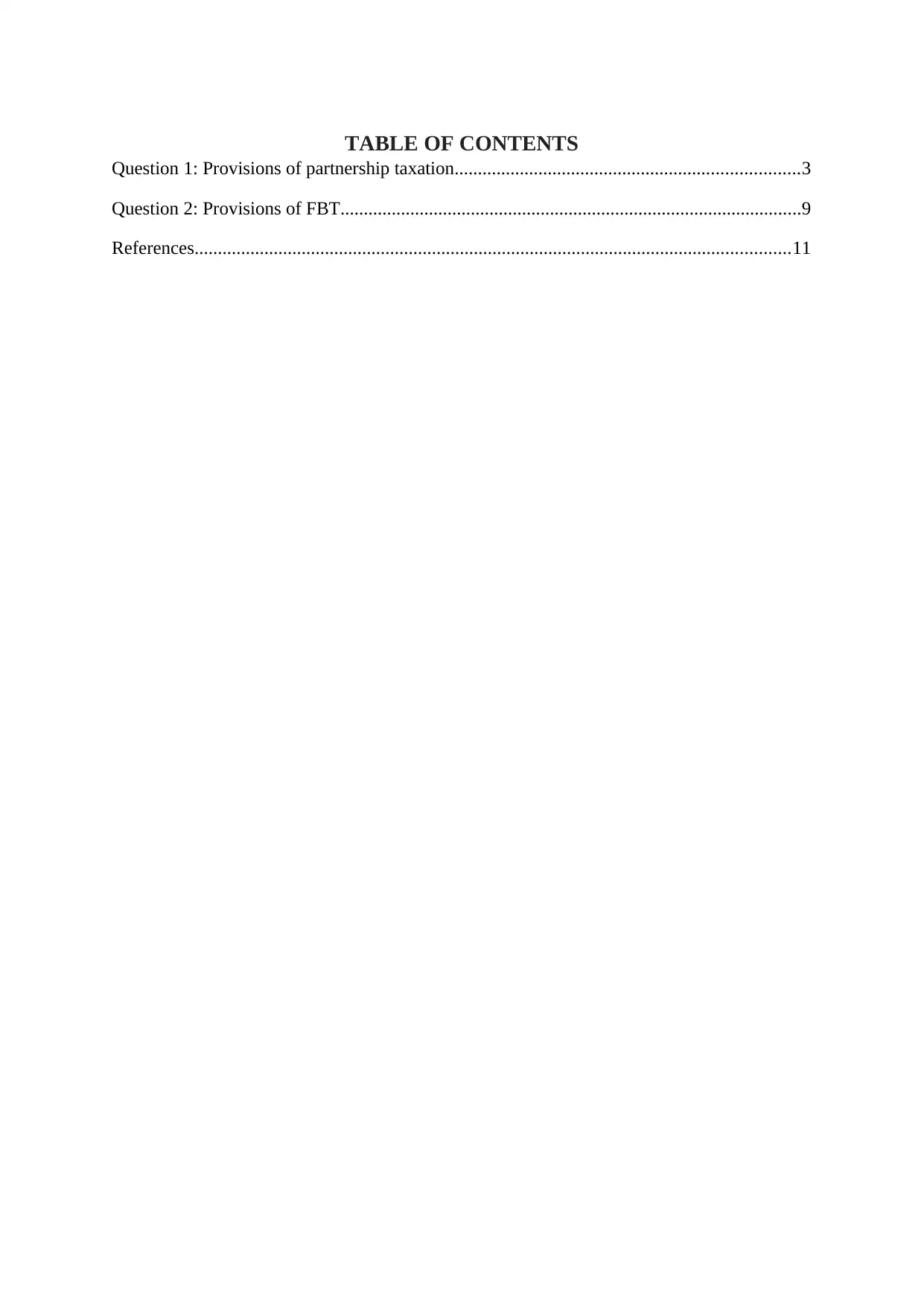
TABLE OF CONTENTS
Question 1: Provisions of partnership taxation..........................................................................3
Question 2: Provisions of FBT...................................................................................................9
References................................................................................................................................11
Question 1: Provisions of partnership taxation..........................................................................3
Question 2: Provisions of FBT...................................................................................................9
References................................................................................................................................11
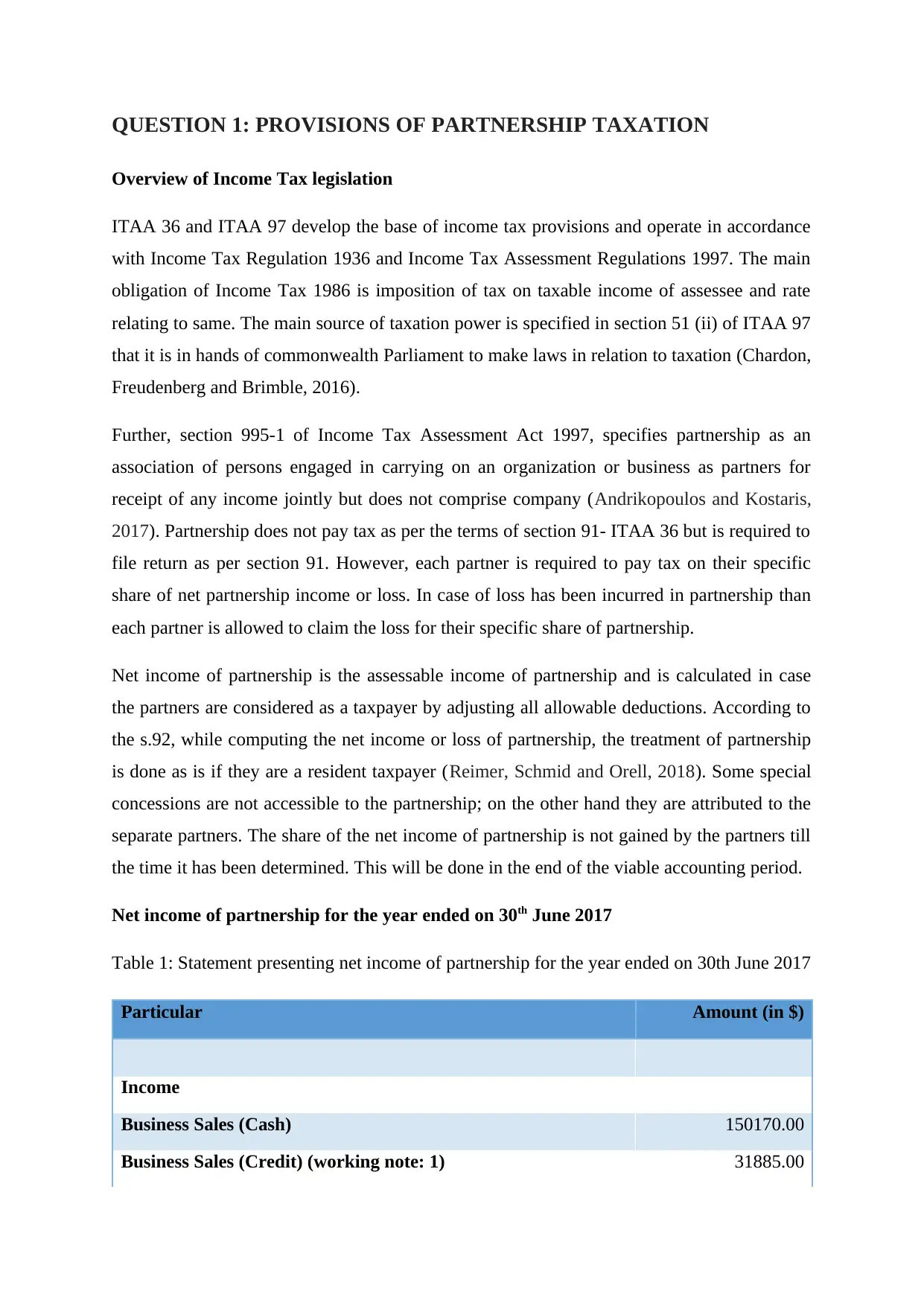
QUESTION 1: PROVISIONS OF PARTNERSHIP TAXATION
Overview of Income Tax legislation
ITAA 36 and ITAA 97 develop the base of income tax provisions and operate in accordance
with Income Tax Regulation 1936 and Income Tax Assessment Regulations 1997. The main
obligation of Income Tax 1986 is imposition of tax on taxable income of assessee and rate
relating to same. The main source of taxation power is specified in section 51 (ii) of ITAA 97
that it is in hands of commonwealth Parliament to make laws in relation to taxation (Chardon,
Freudenberg and Brimble, 2016).
Further, section 995-1 of Income Tax Assessment Act 1997, specifies partnership as an
association of persons engaged in carrying on an organization or business as partners for
receipt of any income jointly but does not comprise company (Andrikopoulos and Kostaris,
2017). Partnership does not pay tax as per the terms of section 91- ITAA 36 but is required to
file return as per section 91. However, each partner is required to pay tax on their specific
share of net partnership income or loss. In case of loss has been incurred in partnership than
each partner is allowed to claim the loss for their specific share of partnership.
Net income of partnership is the assessable income of partnership and is calculated in case
the partners are considered as a taxpayer by adjusting all allowable deductions. According to
the s.92, while computing the net income or loss of partnership, the treatment of partnership
is done as is if they are a resident taxpayer (Reimer, Schmid and Orell, 2018). Some special
concessions are not accessible to the partnership; on the other hand they are attributed to the
separate partners. The share of the net income of partnership is not gained by the partners till
the time it has been determined. This will be done in the end of the viable accounting period.
Net income of partnership for the year ended on 30th June 2017
Table 1: Statement presenting net income of partnership for the year ended on 30th June 2017
Particular Amount (in $)
Income
Business Sales (Cash) 150170.00
Business Sales (Credit) (working note: 1) 31885.00
Overview of Income Tax legislation
ITAA 36 and ITAA 97 develop the base of income tax provisions and operate in accordance
with Income Tax Regulation 1936 and Income Tax Assessment Regulations 1997. The main
obligation of Income Tax 1986 is imposition of tax on taxable income of assessee and rate
relating to same. The main source of taxation power is specified in section 51 (ii) of ITAA 97
that it is in hands of commonwealth Parliament to make laws in relation to taxation (Chardon,
Freudenberg and Brimble, 2016).
Further, section 995-1 of Income Tax Assessment Act 1997, specifies partnership as an
association of persons engaged in carrying on an organization or business as partners for
receipt of any income jointly but does not comprise company (Andrikopoulos and Kostaris,
2017). Partnership does not pay tax as per the terms of section 91- ITAA 36 but is required to
file return as per section 91. However, each partner is required to pay tax on their specific
share of net partnership income or loss. In case of loss has been incurred in partnership than
each partner is allowed to claim the loss for their specific share of partnership.
Net income of partnership is the assessable income of partnership and is calculated in case
the partners are considered as a taxpayer by adjusting all allowable deductions. According to
the s.92, while computing the net income or loss of partnership, the treatment of partnership
is done as is if they are a resident taxpayer (Reimer, Schmid and Orell, 2018). Some special
concessions are not accessible to the partnership; on the other hand they are attributed to the
separate partners. The share of the net income of partnership is not gained by the partners till
the time it has been determined. This will be done in the end of the viable accounting period.
Net income of partnership for the year ended on 30th June 2017
Table 1: Statement presenting net income of partnership for the year ended on 30th June 2017
Particular Amount (in $)
Income
Business Sales (Cash) 150170.00
Business Sales (Credit) (working note: 1) 31885.00
⊘ This is a preview!⊘
Do you want full access?
Subscribe today to unlock all pages.

Trusted by 1+ million students worldwide
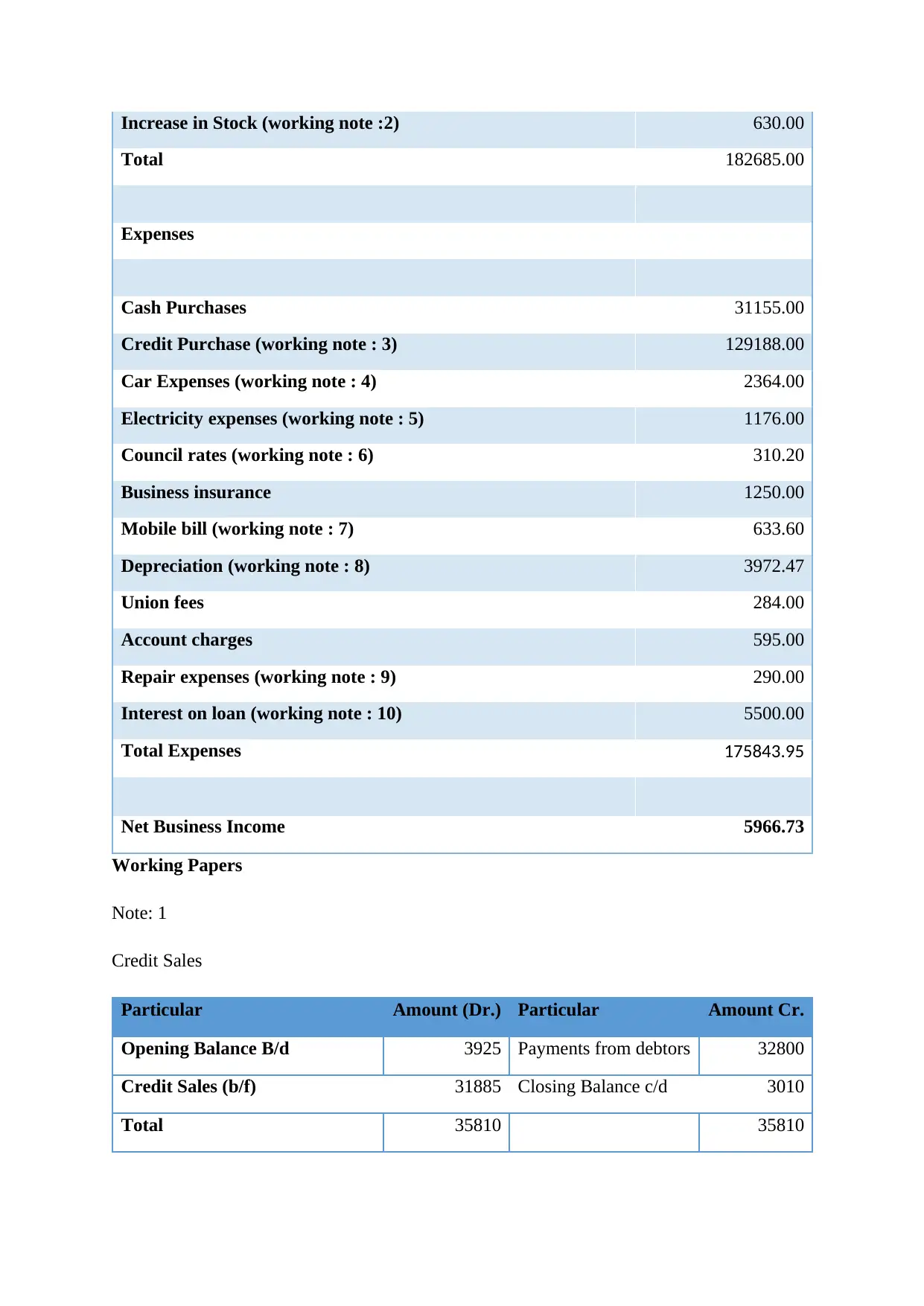
Increase in Stock (working note :2) 630.00
Total 182685.00
Expenses
Cash Purchases 31155.00
Credit Purchase (working note : 3) 129188.00
Car Expenses (working note : 4) 2364.00
Electricity expenses (working note : 5) 1176.00
Council rates (working note : 6) 310.20
Business insurance 1250.00
Mobile bill (working note : 7) 633.60
Depreciation (working note : 8) 3972.47
Union fees 284.00
Account charges 595.00
Repair expenses (working note : 9) 290.00
Interest on loan (working note : 10) 5500.00
Total Expenses 175843.95
Net Business Income 5966.73
Working Papers
Note: 1
Credit Sales
Particular Amount (Dr.) Particular Amount Cr.
Opening Balance B/d 3925 Payments from debtors 32800
Credit Sales (b/f) 31885 Closing Balance c/d 3010
Total 35810 35810
Total 182685.00
Expenses
Cash Purchases 31155.00
Credit Purchase (working note : 3) 129188.00
Car Expenses (working note : 4) 2364.00
Electricity expenses (working note : 5) 1176.00
Council rates (working note : 6) 310.20
Business insurance 1250.00
Mobile bill (working note : 7) 633.60
Depreciation (working note : 8) 3972.47
Union fees 284.00
Account charges 595.00
Repair expenses (working note : 9) 290.00
Interest on loan (working note : 10) 5500.00
Total Expenses 175843.95
Net Business Income 5966.73
Working Papers
Note: 1
Credit Sales
Particular Amount (Dr.) Particular Amount Cr.
Opening Balance B/d 3925 Payments from debtors 32800
Credit Sales (b/f) 31885 Closing Balance c/d 3010
Total 35810 35810
Paraphrase This Document
Need a fresh take? Get an instant paraphrase of this document with our AI Paraphraser
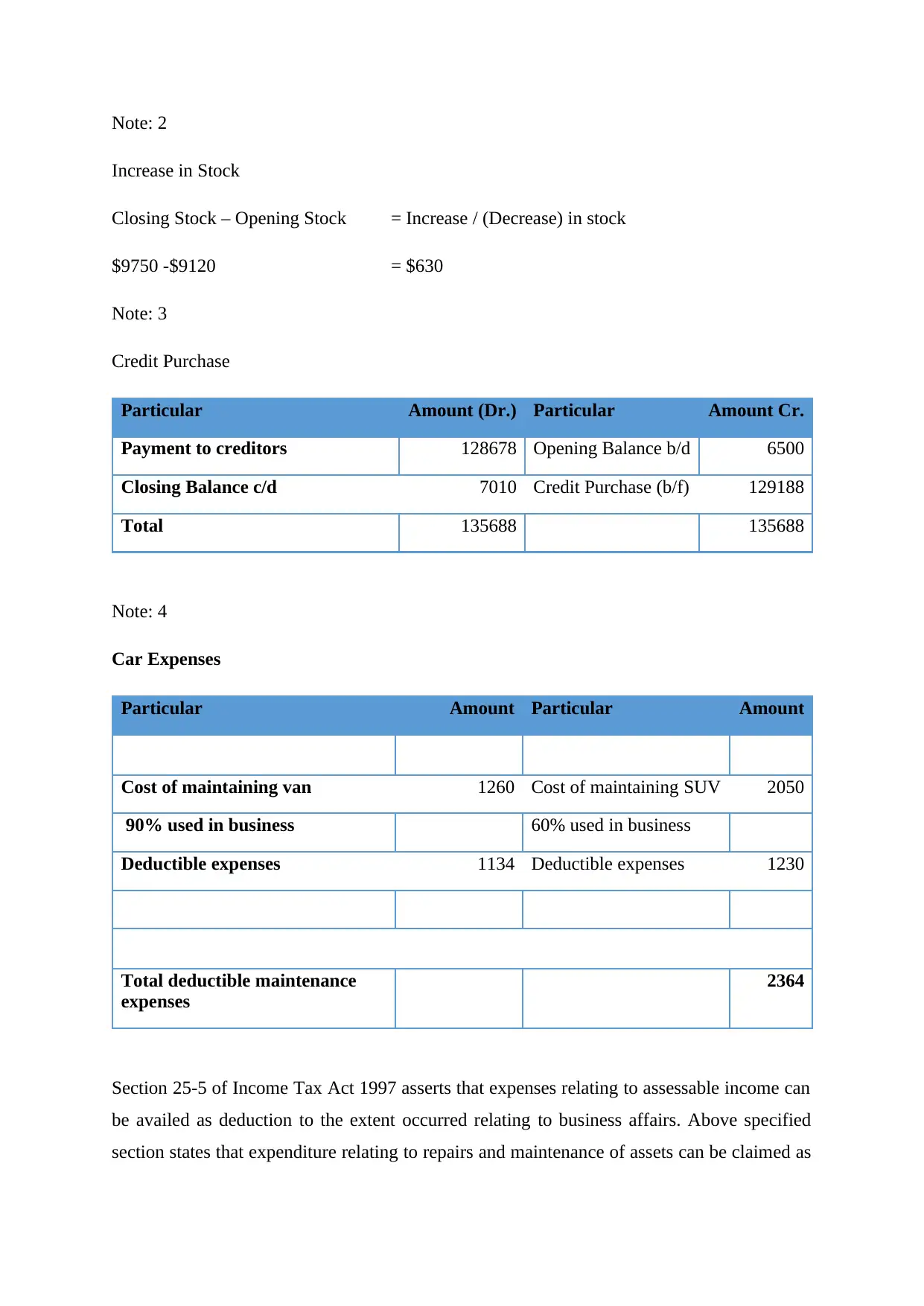
Note: 2
Increase in Stock
Closing Stock – Opening Stock = Increase / (Decrease) in stock
$9750 -$9120 = $630
Note: 3
Credit Purchase
Particular Amount (Dr.) Particular Amount Cr.
Payment to creditors 128678 Opening Balance b/d 6500
Closing Balance c/d 7010 Credit Purchase (b/f) 129188
Total 135688 135688
Note: 4
Car Expenses
Particular Amount Particular Amount
Cost of maintaining van 1260 Cost of maintaining SUV 2050
90% used in business 60% used in business
Deductible expenses 1134 Deductible expenses 1230
Total deductible maintenance
expenses
2364
Section 25-5 of Income Tax Act 1997 asserts that expenses relating to assessable income can
be availed as deduction to the extent occurred relating to business affairs. Above specified
section states that expenditure relating to repairs and maintenance of assets can be claimed as
Increase in Stock
Closing Stock – Opening Stock = Increase / (Decrease) in stock
$9750 -$9120 = $630
Note: 3
Credit Purchase
Particular Amount (Dr.) Particular Amount Cr.
Payment to creditors 128678 Opening Balance b/d 6500
Closing Balance c/d 7010 Credit Purchase (b/f) 129188
Total 135688 135688
Note: 4
Car Expenses
Particular Amount Particular Amount
Cost of maintaining van 1260 Cost of maintaining SUV 2050
90% used in business 60% used in business
Deductible expenses 1134 Deductible expenses 1230
Total deductible maintenance
expenses
2364
Section 25-5 of Income Tax Act 1997 asserts that expenses relating to assessable income can
be availed as deduction to the extent occurred relating to business affairs. Above specified
section states that expenditure relating to repairs and maintenance of assets can be claimed as
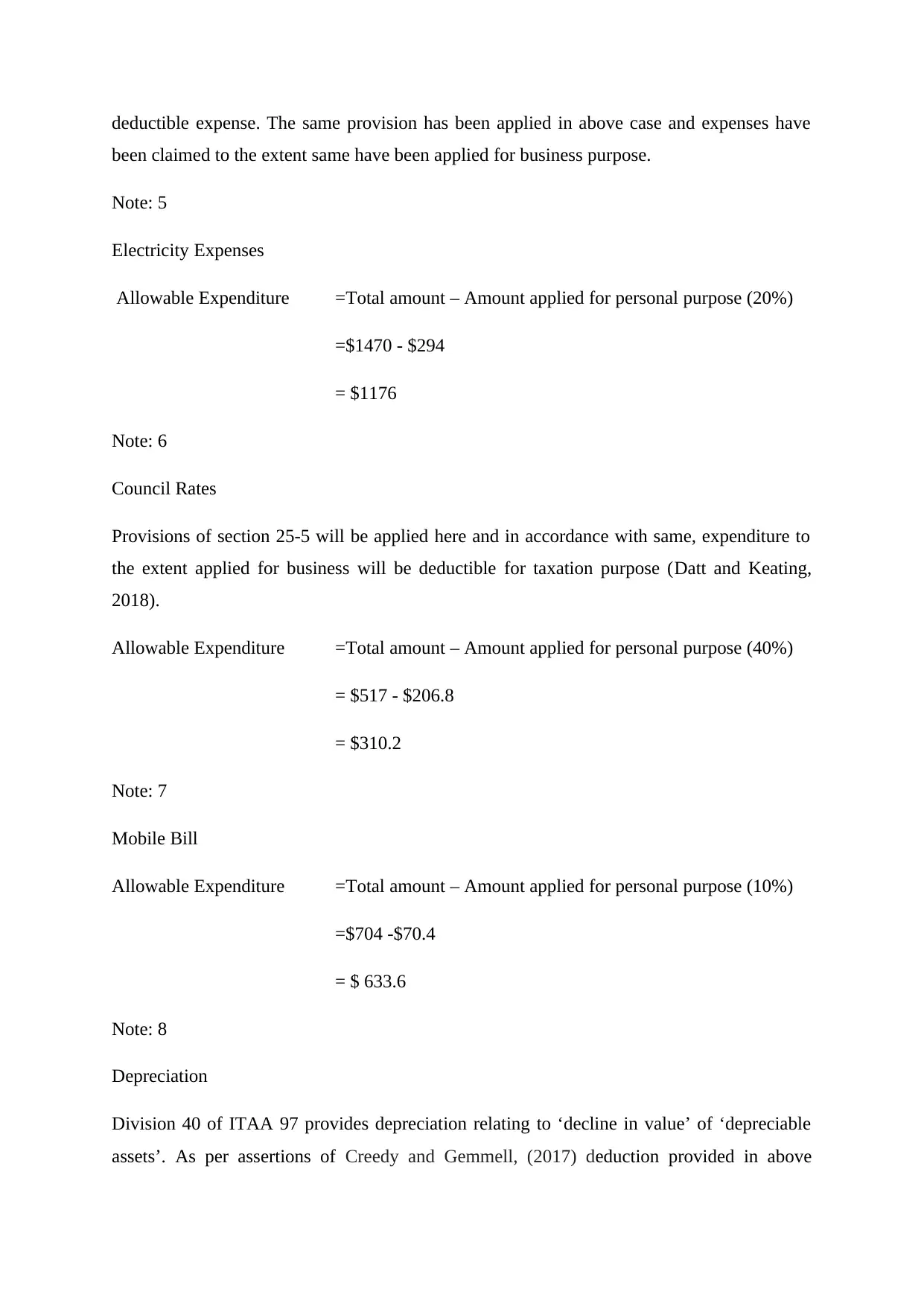
deductible expense. The same provision has been applied in above case and expenses have
been claimed to the extent same have been applied for business purpose.
Note: 5
Electricity Expenses
Allowable Expenditure =Total amount – Amount applied for personal purpose (20%)
=$1470 - $294
= $1176
Note: 6
Council Rates
Provisions of section 25-5 will be applied here and in accordance with same, expenditure to
the extent applied for business will be deductible for taxation purpose (Datt and Keating,
2018).
Allowable Expenditure =Total amount – Amount applied for personal purpose (40%)
= $517 - $206.8
= $310.2
Note: 7
Mobile Bill
Allowable Expenditure =Total amount – Amount applied for personal purpose (10%)
=$704 -$70.4
= $ 633.6
Note: 8
Depreciation
Division 40 of ITAA 97 provides depreciation relating to ‘decline in value’ of ‘depreciable
assets’. As per assertions of Creedy and Gemmell, (2017) deduction provided in above
been claimed to the extent same have been applied for business purpose.
Note: 5
Electricity Expenses
Allowable Expenditure =Total amount – Amount applied for personal purpose (20%)
=$1470 - $294
= $1176
Note: 6
Council Rates
Provisions of section 25-5 will be applied here and in accordance with same, expenditure to
the extent applied for business will be deductible for taxation purpose (Datt and Keating,
2018).
Allowable Expenditure =Total amount – Amount applied for personal purpose (40%)
= $517 - $206.8
= $310.2
Note: 7
Mobile Bill
Allowable Expenditure =Total amount – Amount applied for personal purpose (10%)
=$704 -$70.4
= $ 633.6
Note: 8
Depreciation
Division 40 of ITAA 97 provides depreciation relating to ‘decline in value’ of ‘depreciable
assets’. As per assertions of Creedy and Gemmell, (2017) deduction provided in above
⊘ This is a preview!⊘
Do you want full access?
Subscribe today to unlock all pages.

Trusted by 1+ million students worldwide
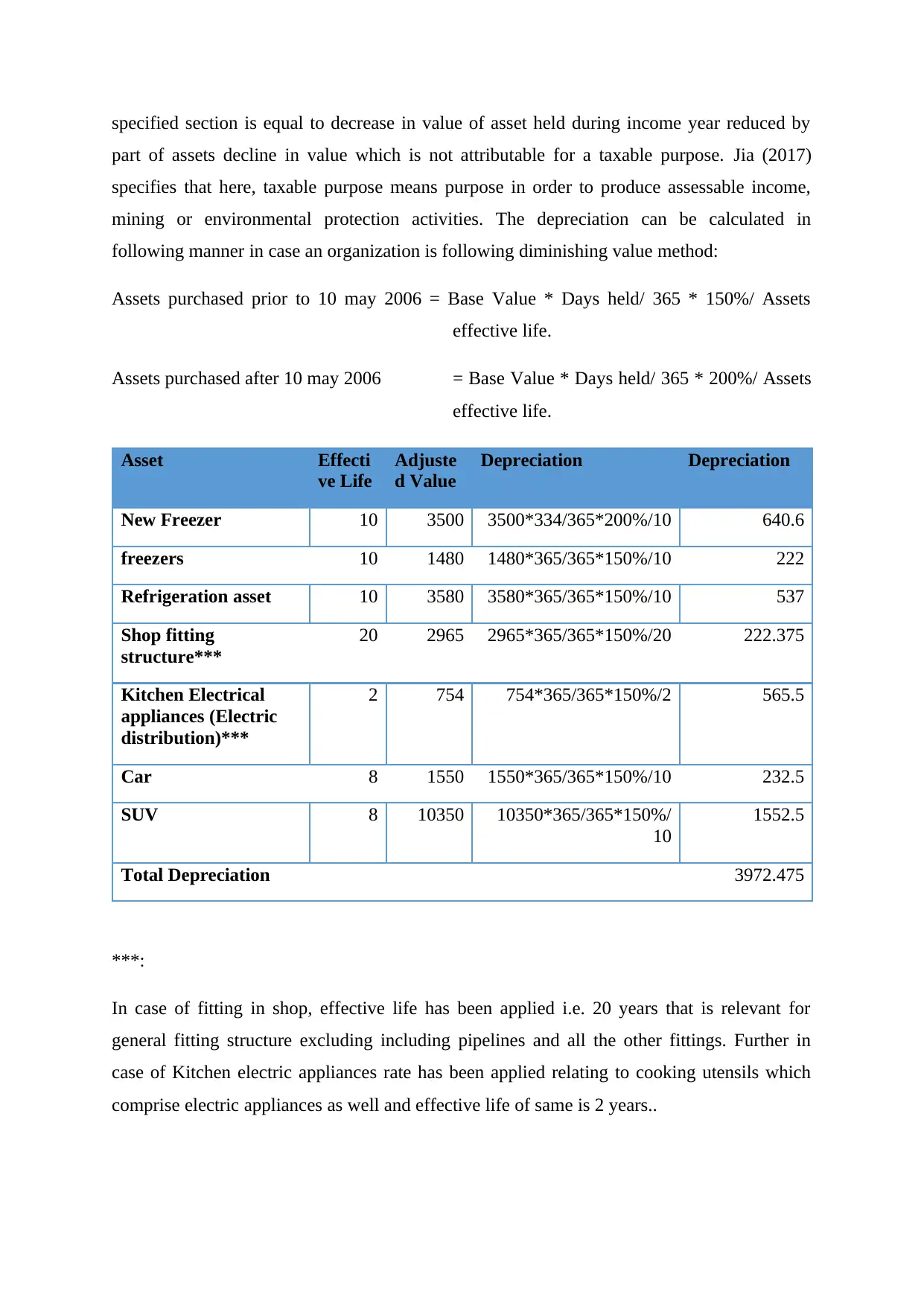
specified section is equal to decrease in value of asset held during income year reduced by
part of assets decline in value which is not attributable for a taxable purpose. Jia (2017)
specifies that here, taxable purpose means purpose in order to produce assessable income,
mining or environmental protection activities. The depreciation can be calculated in
following manner in case an organization is following diminishing value method:
Assets purchased prior to 10 may 2006 = Base Value * Days held/ 365 * 150%/ Assets
effective life.
Assets purchased after 10 may 2006 = Base Value * Days held/ 365 * 200%/ Assets
effective life.
Asset Effecti
ve Life
Adjuste
d Value
Depreciation Depreciation
New Freezer 10 3500 3500*334/365*200%/10 640.6
freezers 10 1480 1480*365/365*150%/10 222
Refrigeration asset 10 3580 3580*365/365*150%/10 537
Shop fitting
structure***
20 2965 2965*365/365*150%/20 222.375
Kitchen Electrical
appliances (Electric
distribution)***
2 754 754*365/365*150%/2 565.5
Car 8 1550 1550*365/365*150%/10 232.5
SUV 8 10350 10350*365/365*150%/
10
1552.5
Total Depreciation 3972.475
***:
In case of fitting in shop, effective life has been applied i.e. 20 years that is relevant for
general fitting structure excluding including pipelines and all the other fittings. Further in
case of Kitchen electric appliances rate has been applied relating to cooking utensils which
comprise electric appliances as well and effective life of same is 2 years..
part of assets decline in value which is not attributable for a taxable purpose. Jia (2017)
specifies that here, taxable purpose means purpose in order to produce assessable income,
mining or environmental protection activities. The depreciation can be calculated in
following manner in case an organization is following diminishing value method:
Assets purchased prior to 10 may 2006 = Base Value * Days held/ 365 * 150%/ Assets
effective life.
Assets purchased after 10 may 2006 = Base Value * Days held/ 365 * 200%/ Assets
effective life.
Asset Effecti
ve Life
Adjuste
d Value
Depreciation Depreciation
New Freezer 10 3500 3500*334/365*200%/10 640.6
freezers 10 1480 1480*365/365*150%/10 222
Refrigeration asset 10 3580 3580*365/365*150%/10 537
Shop fitting
structure***
20 2965 2965*365/365*150%/20 222.375
Kitchen Electrical
appliances (Electric
distribution)***
2 754 754*365/365*150%/2 565.5
Car 8 1550 1550*365/365*150%/10 232.5
SUV 8 10350 10350*365/365*150%/
10
1552.5
Total Depreciation 3972.475
***:
In case of fitting in shop, effective life has been applied i.e. 20 years that is relevant for
general fitting structure excluding including pipelines and all the other fittings. Further in
case of Kitchen electric appliances rate has been applied relating to cooking utensils which
comprise electric appliances as well and effective life of same is 2 years..
Paraphrase This Document
Need a fresh take? Get an instant paraphrase of this document with our AI Paraphraser
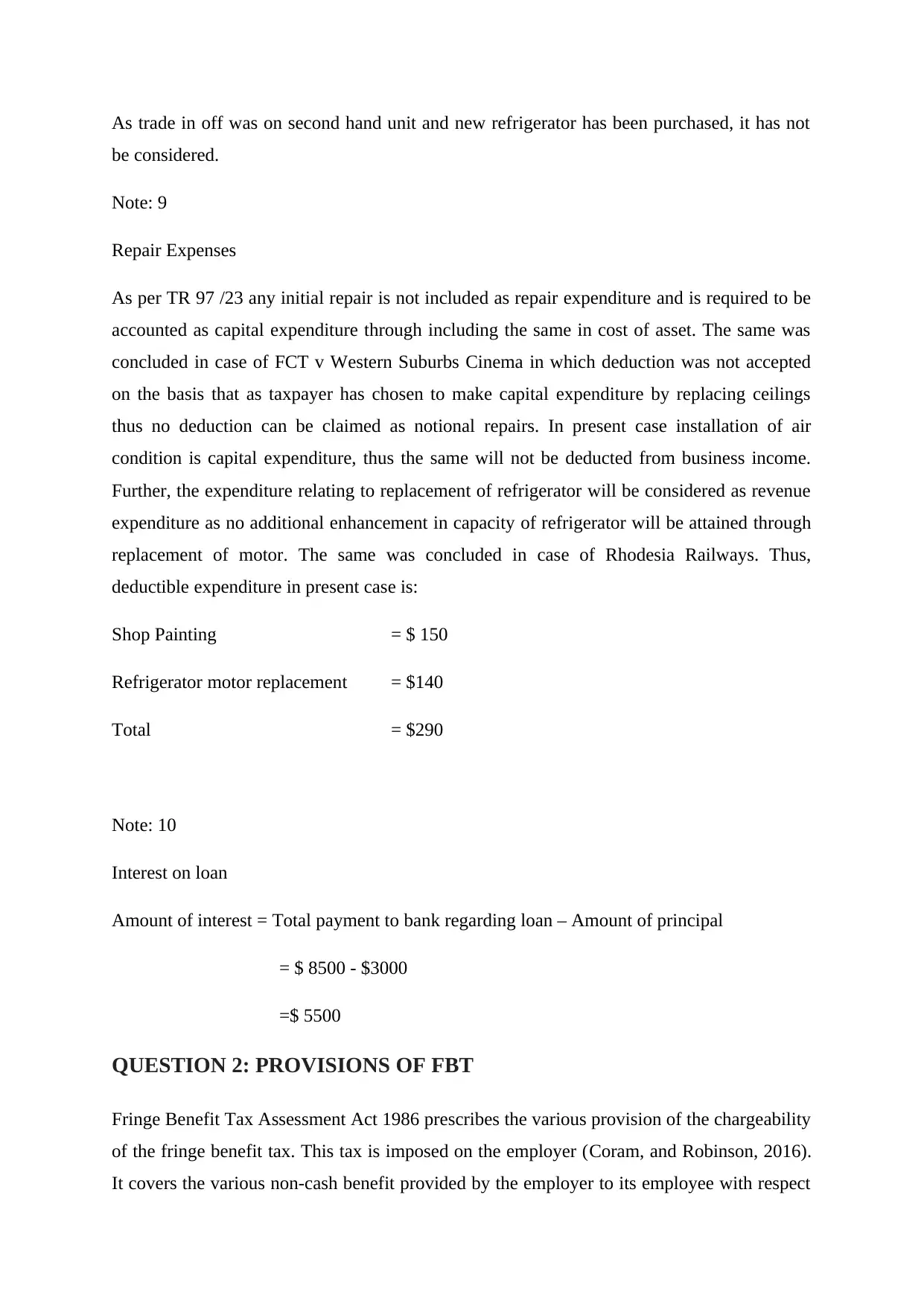
As trade in off was on second hand unit and new refrigerator has been purchased, it has not
be considered.
Note: 9
Repair Expenses
As per TR 97 /23 any initial repair is not included as repair expenditure and is required to be
accounted as capital expenditure through including the same in cost of asset. The same was
concluded in case of FCT v Western Suburbs Cinema in which deduction was not accepted
on the basis that as taxpayer has chosen to make capital expenditure by replacing ceilings
thus no deduction can be claimed as notional repairs. In present case installation of air
condition is capital expenditure, thus the same will not be deducted from business income.
Further, the expenditure relating to replacement of refrigerator will be considered as revenue
expenditure as no additional enhancement in capacity of refrigerator will be attained through
replacement of motor. The same was concluded in case of Rhodesia Railways. Thus,
deductible expenditure in present case is:
Shop Painting = $ 150
Refrigerator motor replacement = $140
Total = $290
Note: 10
Interest on loan
Amount of interest = Total payment to bank regarding loan – Amount of principal
= $ 8500 - $3000
=$ 5500
QUESTION 2: PROVISIONS OF FBT
Fringe Benefit Tax Assessment Act 1986 prescribes the various provision of the chargeability
of the fringe benefit tax. This tax is imposed on the employer (Coram, and Robinson, 2016).
It covers the various non-cash benefit provided by the employer to its employee with respect
be considered.
Note: 9
Repair Expenses
As per TR 97 /23 any initial repair is not included as repair expenditure and is required to be
accounted as capital expenditure through including the same in cost of asset. The same was
concluded in case of FCT v Western Suburbs Cinema in which deduction was not accepted
on the basis that as taxpayer has chosen to make capital expenditure by replacing ceilings
thus no deduction can be claimed as notional repairs. In present case installation of air
condition is capital expenditure, thus the same will not be deducted from business income.
Further, the expenditure relating to replacement of refrigerator will be considered as revenue
expenditure as no additional enhancement in capacity of refrigerator will be attained through
replacement of motor. The same was concluded in case of Rhodesia Railways. Thus,
deductible expenditure in present case is:
Shop Painting = $ 150
Refrigerator motor replacement = $140
Total = $290
Note: 10
Interest on loan
Amount of interest = Total payment to bank regarding loan – Amount of principal
= $ 8500 - $3000
=$ 5500
QUESTION 2: PROVISIONS OF FBT
Fringe Benefit Tax Assessment Act 1986 prescribes the various provision of the chargeability
of the fringe benefit tax. This tax is imposed on the employer (Coram, and Robinson, 2016).
It covers the various non-cash benefit provided by the employer to its employee with respect
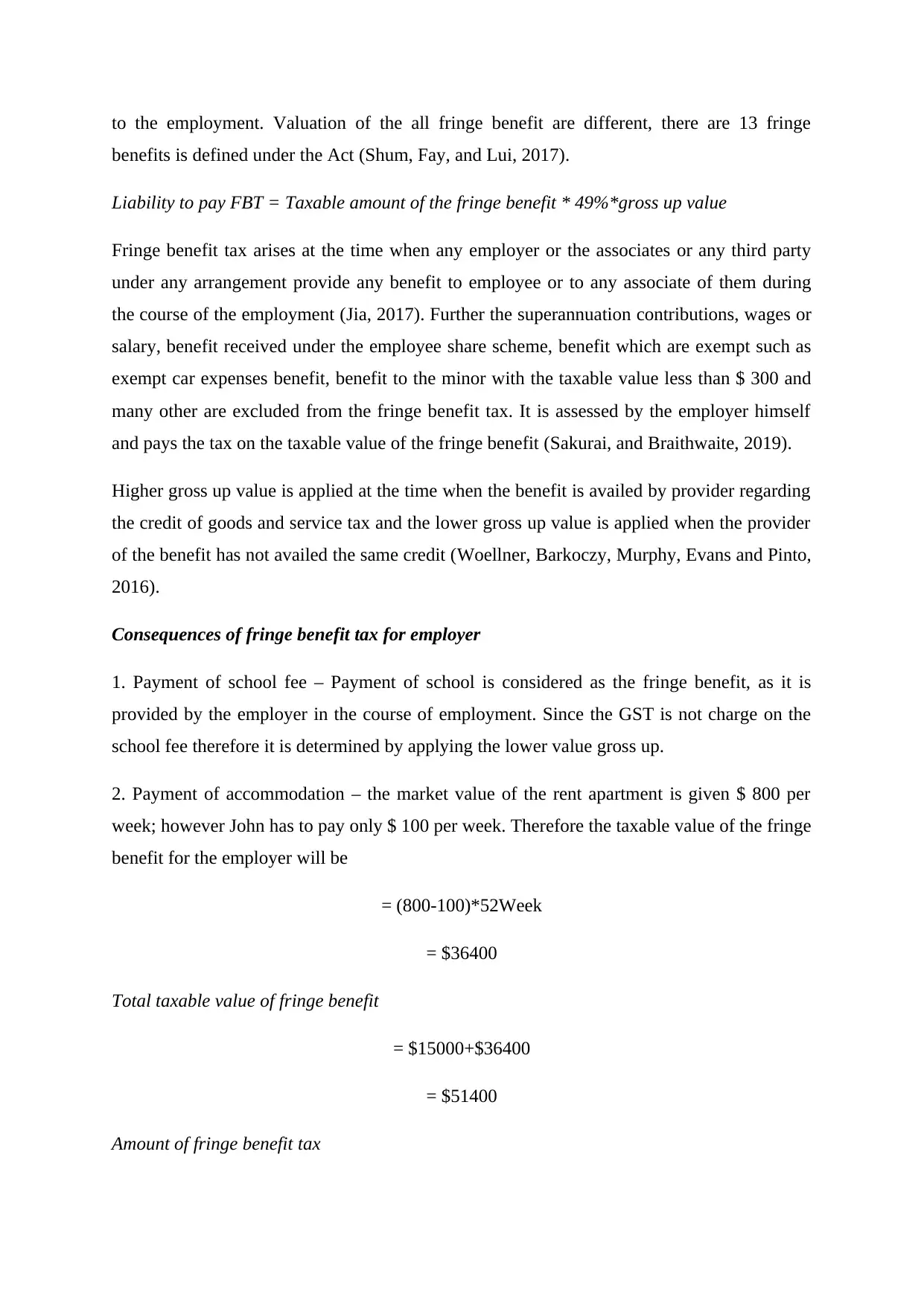
to the employment. Valuation of the all fringe benefit are different, there are 13 fringe
benefits is defined under the Act (Shum, Fay, and Lui, 2017).
Liability to pay FBT = Taxable amount of the fringe benefit * 49%*gross up value
Fringe benefit tax arises at the time when any employer or the associates or any third party
under any arrangement provide any benefit to employee or to any associate of them during
the course of the employment (Jia, 2017). Further the superannuation contributions, wages or
salary, benefit received under the employee share scheme, benefit which are exempt such as
exempt car expenses benefit, benefit to the minor with the taxable value less than $ 300 and
many other are excluded from the fringe benefit tax. It is assessed by the employer himself
and pays the tax on the taxable value of the fringe benefit (Sakurai, and Braithwaite, 2019).
Higher gross up value is applied at the time when the benefit is availed by provider regarding
the credit of goods and service tax and the lower gross up value is applied when the provider
of the benefit has not availed the same credit (Woellner, Barkoczy, Murphy, Evans and Pinto,
2016).
Consequences of fringe benefit tax for employer
1. Payment of school fee – Payment of school is considered as the fringe benefit, as it is
provided by the employer in the course of employment. Since the GST is not charge on the
school fee therefore it is determined by applying the lower value gross up.
2. Payment of accommodation – the market value of the rent apartment is given $ 800 per
week; however John has to pay only $ 100 per week. Therefore the taxable value of the fringe
benefit for the employer will be
= (800-100)*52Week
= $36400
Total taxable value of fringe benefit
= $15000+$36400
= $51400
Amount of fringe benefit tax
benefits is defined under the Act (Shum, Fay, and Lui, 2017).
Liability to pay FBT = Taxable amount of the fringe benefit * 49%*gross up value
Fringe benefit tax arises at the time when any employer or the associates or any third party
under any arrangement provide any benefit to employee or to any associate of them during
the course of the employment (Jia, 2017). Further the superannuation contributions, wages or
salary, benefit received under the employee share scheme, benefit which are exempt such as
exempt car expenses benefit, benefit to the minor with the taxable value less than $ 300 and
many other are excluded from the fringe benefit tax. It is assessed by the employer himself
and pays the tax on the taxable value of the fringe benefit (Sakurai, and Braithwaite, 2019).
Higher gross up value is applied at the time when the benefit is availed by provider regarding
the credit of goods and service tax and the lower gross up value is applied when the provider
of the benefit has not availed the same credit (Woellner, Barkoczy, Murphy, Evans and Pinto,
2016).
Consequences of fringe benefit tax for employer
1. Payment of school fee – Payment of school is considered as the fringe benefit, as it is
provided by the employer in the course of employment. Since the GST is not charge on the
school fee therefore it is determined by applying the lower value gross up.
2. Payment of accommodation – the market value of the rent apartment is given $ 800 per
week; however John has to pay only $ 100 per week. Therefore the taxable value of the fringe
benefit for the employer will be
= (800-100)*52Week
= $36400
Total taxable value of fringe benefit
= $15000+$36400
= $51400
Amount of fringe benefit tax
⊘ This is a preview!⊘
Do you want full access?
Subscribe today to unlock all pages.

Trusted by 1+ million students worldwide
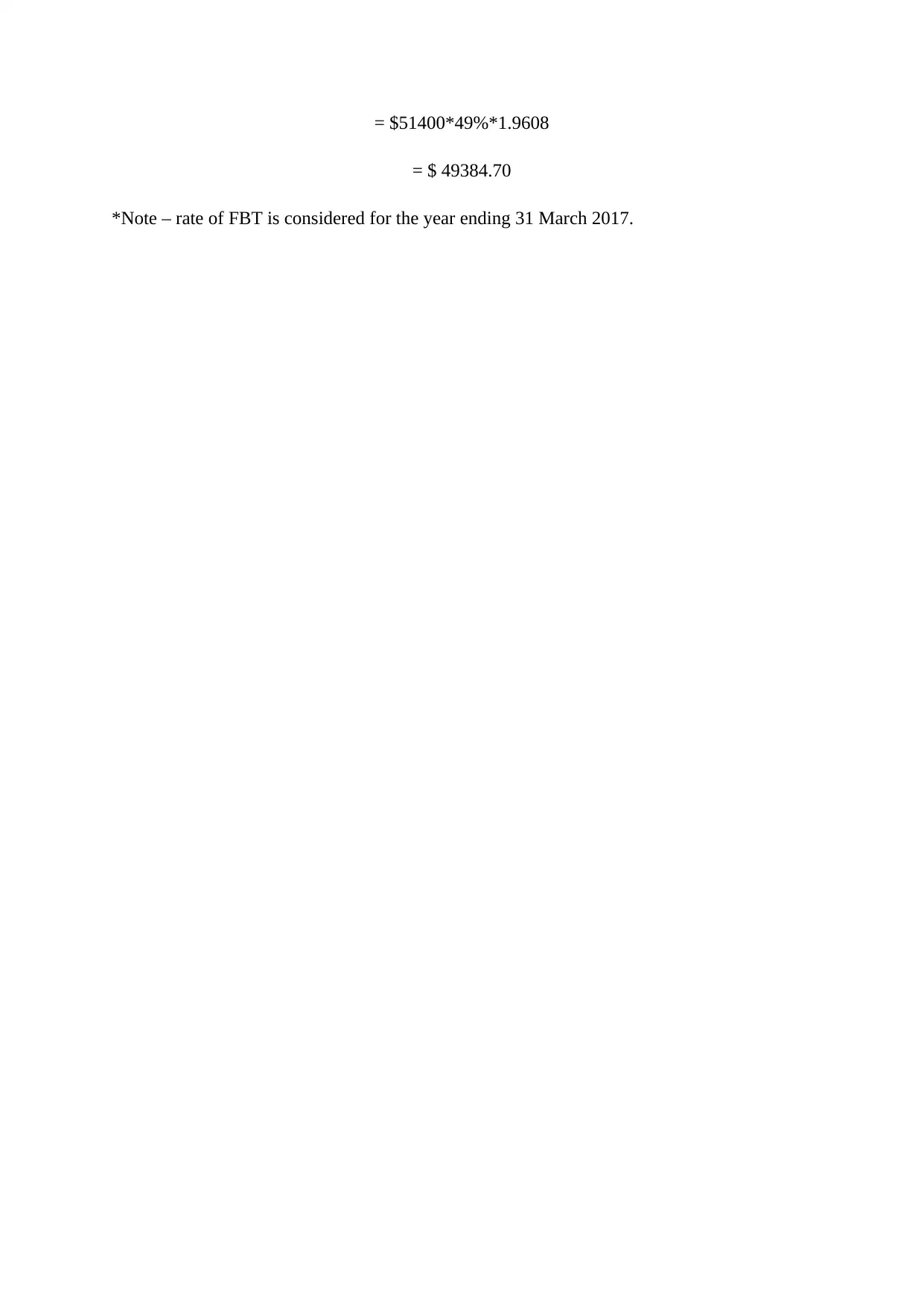
= $51400*49%*1.9608
= $ 49384.70
*Note – rate of FBT is considered for the year ending 31 March 2017.
= $ 49384.70
*Note – rate of FBT is considered for the year ending 31 March 2017.
Paraphrase This Document
Need a fresh take? Get an instant paraphrase of this document with our AI Paraphraser
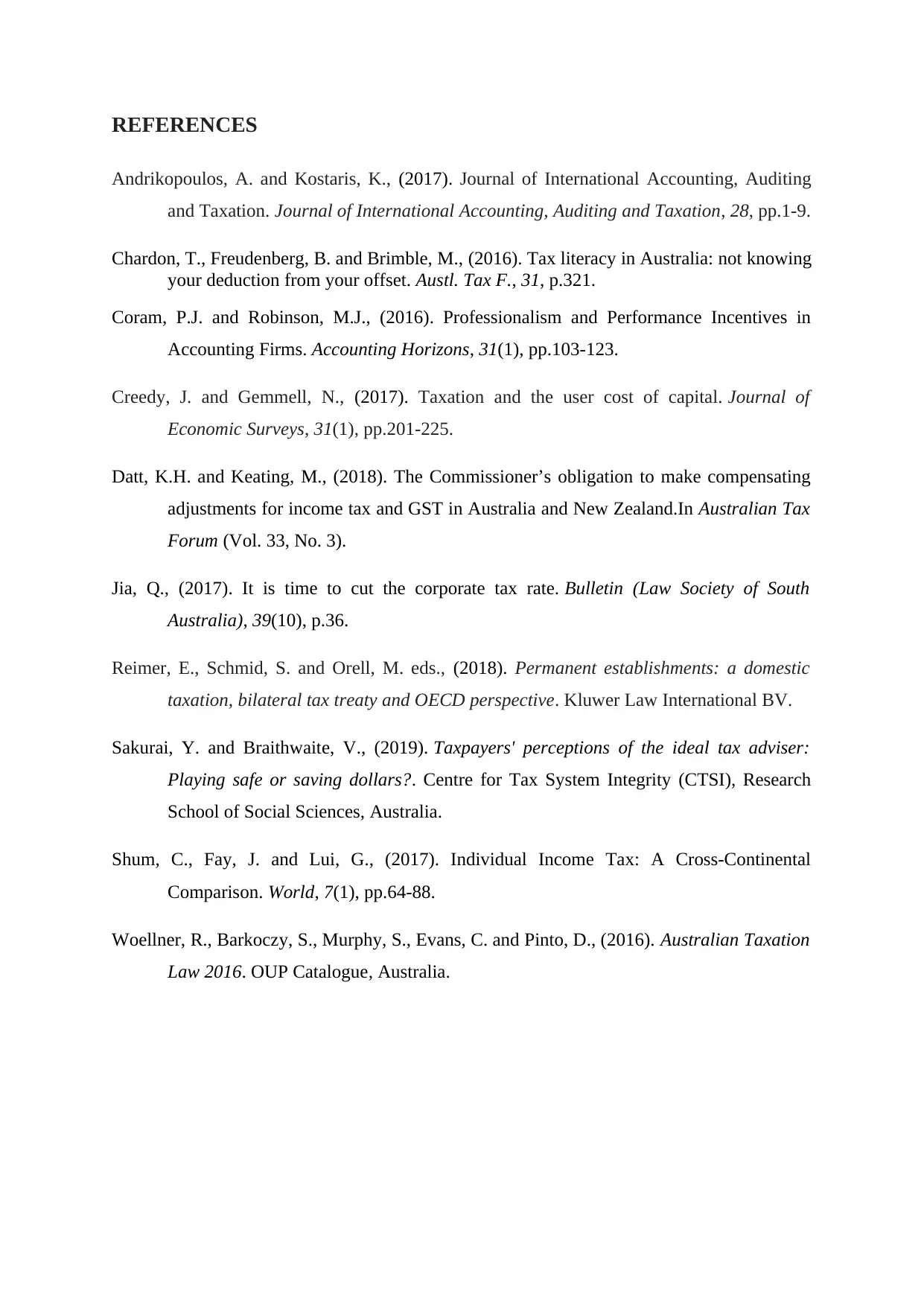
REFERENCES
Andrikopoulos, A. and Kostaris, K., (2017). Journal of International Accounting, Auditing
and Taxation. Journal of International Accounting, Auditing and Taxation, 28, pp.1-9.
Chardon, T., Freudenberg, B. and Brimble, M., (2016). Tax literacy in Australia: not knowing
your deduction from your offset. Austl. Tax F., 31, p.321.
Coram, P.J. and Robinson, M.J., (2016). Professionalism and Performance Incentives in
Accounting Firms. Accounting Horizons, 31(1), pp.103-123.
Creedy, J. and Gemmell, N., (2017). Taxation and the user cost of capital. Journal of
Economic Surveys, 31(1), pp.201-225.
Datt, K.H. and Keating, M., (2018). The Commissioner’s obligation to make compensating
adjustments for income tax and GST in Australia and New Zealand.In Australian Tax
Forum (Vol. 33, No. 3).
Jia, Q., (2017). It is time to cut the corporate tax rate. Bulletin (Law Society of South
Australia), 39(10), p.36.
Reimer, E., Schmid, S. and Orell, M. eds., (2018). Permanent establishments: a domestic
taxation, bilateral tax treaty and OECD perspective. Kluwer Law International BV.
Sakurai, Y. and Braithwaite, V., (2019). Taxpayers' perceptions of the ideal tax adviser:
Playing safe or saving dollars?. Centre for Tax System Integrity (CTSI), Research
School of Social Sciences, Australia.
Shum, C., Fay, J. and Lui, G., (2017). Individual Income Tax: A Cross-Continental
Comparison. World, 7(1), pp.64-88.
Woellner, R., Barkoczy, S., Murphy, S., Evans, C. and Pinto, D., (2016). Australian Taxation
Law 2016. OUP Catalogue, Australia.
Andrikopoulos, A. and Kostaris, K., (2017). Journal of International Accounting, Auditing
and Taxation. Journal of International Accounting, Auditing and Taxation, 28, pp.1-9.
Chardon, T., Freudenberg, B. and Brimble, M., (2016). Tax literacy in Australia: not knowing
your deduction from your offset. Austl. Tax F., 31, p.321.
Coram, P.J. and Robinson, M.J., (2016). Professionalism and Performance Incentives in
Accounting Firms. Accounting Horizons, 31(1), pp.103-123.
Creedy, J. and Gemmell, N., (2017). Taxation and the user cost of capital. Journal of
Economic Surveys, 31(1), pp.201-225.
Datt, K.H. and Keating, M., (2018). The Commissioner’s obligation to make compensating
adjustments for income tax and GST in Australia and New Zealand.In Australian Tax
Forum (Vol. 33, No. 3).
Jia, Q., (2017). It is time to cut the corporate tax rate. Bulletin (Law Society of South
Australia), 39(10), p.36.
Reimer, E., Schmid, S. and Orell, M. eds., (2018). Permanent establishments: a domestic
taxation, bilateral tax treaty and OECD perspective. Kluwer Law International BV.
Sakurai, Y. and Braithwaite, V., (2019). Taxpayers' perceptions of the ideal tax adviser:
Playing safe or saving dollars?. Centre for Tax System Integrity (CTSI), Research
School of Social Sciences, Australia.
Shum, C., Fay, J. and Lui, G., (2017). Individual Income Tax: A Cross-Continental
Comparison. World, 7(1), pp.64-88.
Woellner, R., Barkoczy, S., Murphy, S., Evans, C. and Pinto, D., (2016). Australian Taxation
Law 2016. OUP Catalogue, Australia.
1 out of 11
Related Documents
Your All-in-One AI-Powered Toolkit for Academic Success.
+13062052269
info@desklib.com
Available 24*7 on WhatsApp / Email
![[object Object]](/_next/static/media/star-bottom.7253800d.svg)
Unlock your academic potential
Copyright © 2020–2025 A2Z Services. All Rights Reserved. Developed and managed by ZUCOL.





